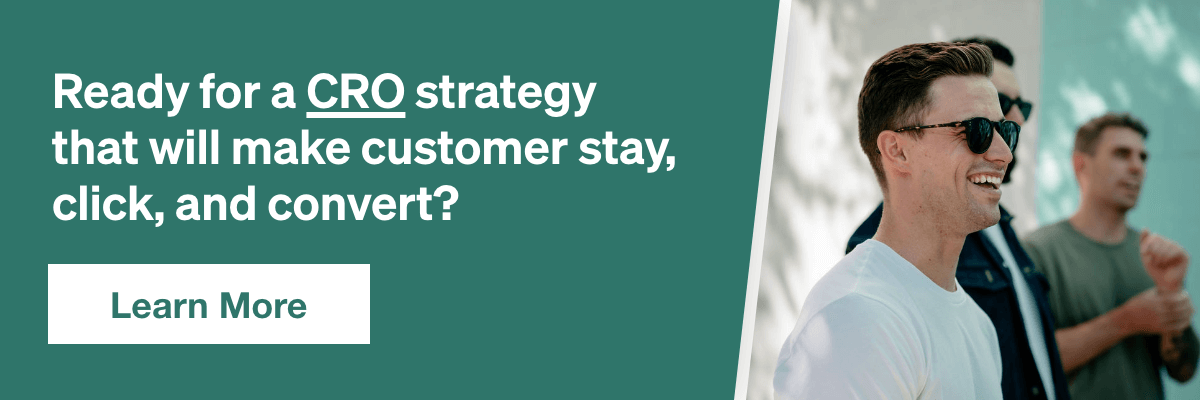How to Improve Conversion Rate

In digital marketing, the conversion rate is the percentage of people who visit your website and take a desired action, like buying a product or signing up for your service. The dream is to have a 100% conversion rate—although that’s highly unlikely. In fact, the average average conversion rate across all industries is just 2%.1
The good news is that there are plenty of ways to increase conversion rate. These techniques make up a process known as conversion rate optimization (CRO).
Below, we’ll review 11 powerful CRO marketing tactics that can move the needle on your website conversion rate.
How to Increase Conversion Rate: 11 Effective Techniques
What is conversion rate optimization? The process of CRO involves three main steps:
- Identifying why a site visitor isn’t converting
- Making changes on your website to address these conversion obstacles
- Testing these changes to find out if they’re actually working
To put these steps into action, simply try out these 11 tried-and-true CRO tactics and achieve customer satisfaction:
#1 Increase Your Page Speed
These days, online shoppers have high expectations. Notably, they expect websites to load quickly. Even a delay of a few seconds may send potential customers clicking the “back” button and giving your competitor their business instead. In fact, forty percent of people will abandon a website if it takes more than 3 seconds to load.2
If you even want the chance to acquire more conversions, you need to keep website visitors on your page long enough for it to load. Thus, speeding up your website’s loading time is a simple way to improve your conversion rate.
#2 Optimize For Mobile
Did you know that over 50% of online shopping experiences take place on a mobile device?3 If you want to win over this large swath of customers, you need to ensure your website renders properly on mobile.
You should also carefully review the steps involved in your mobile checkout process. Make checking out as simple as possible by letting guests pay with Paypal, GooglePay, or ApplePay—the fewer forms they need to fill out, the more likely they’ll be to complete their purchase.
#3 Write a Compelling Headline
Roughly 80% of website visitors will read your web page’s headline, but only 20% will read anything else.4 Thus, getting the wording of your headline just right is essential for your conversion rate.
Your headline should clearly communicate your value proposition. Every word of your headline matters, so test out a few different versions of it to see which one performs the best.
It’s amazing how tweaking a few words within your headline can make a massive difference in your conversion rate.
#4 Include an Action-Inspiring CTA
When it comes to conversion rate optimization, your web page’s call-to-action (CTA) is another crucial component. Wondering how to write a call to action that converts?Effective CTAs are:
- Actionable – The purpose of a CTA is to inspire action, so you must use action-oriented language, like “Download Now” or “Yes, Give Me That Discount!”
- Preceded by persuasive copy – To motivate website visitors to click on a CTA button, you need to explain the value of your product, service, or promotional offer. Explain how your offer (whether it’s a product or service, a downloadable piece of content, or a free trial) will benefit them.
Use language that resonates with your target audience and addresses their pain points. If you get your messaging right, they’ll be much more likely to click on the call to action and convert. - Easy to find – If website visitors can’t find your CTA, they can’t click on it. In turn, your CTA must be easy to find. Make sure it’s positioned strategically on the web page in a location that draws the eye. You can use bright colors to help it stand out.
- One to a page – Even if you have multiple offers to share with your website visitors, limit your CTAs to one per web page. This way, you can tailor everything on the page to guide your website visitors towards this CTA. A single, focused CTA will convert much better than multiple, vague CTAs.
#5 Remove Distractions From Your Landing Pages
Imagine that you’re shopping in a beautifully designed store. Every item is showcased exquisitely in perfect lighting. The sales associate is ready to answer all of your questions.
Now think about shopping in a messy store where all of the items are scattered around haphazardly. You have to dig around to find each product and the sales clerk is nowhere to be found. You would probably leave this store without making a purchase simply because the shopping experience is too much trouble.
These two experiences show that buying a product or service is easier when there are fewer distractions. Don’t make your website visitors dig to find the crucial information they need to convert. Instead, just show them the essentials of a high landing page conversion rate, which include:
- A compelling headline and subheading
- An overview of the benefits and features of your product or service
- Social proof, including testimonials and a product review
- An attractive visual of your product or service
- A click-worthy CTA button
#6 Simplify Your Forms
We’ve all been there—you go to fill out a form on a website and give up halfway because it was just too long.
If a form asks for too much information, many people won’t complete it. They’ll perceive the form as being too invasive or tedious.
As a result, removing unnecessary form fields is an effective way to increase your form fill conversion rate.
#7 Gain Insights From Heat Mapping
If you’re not sure what’s essential and non-essential on your web pages, heat mapping can help you find out.
Heat mapping shows you exactly where your website visitors click when they explore your web page. In turn, it helps you understand what content they find most engaging. Many heat mapping software also allow you to watch screen recordings of your website visitors’ sessions, enabling you to see:
- How far down the page they scroll
- Where they stop to read more
- How long they look at each section
- How much of a form they fill out
By analyzing this behavior, you can develop a much better understanding of your website’s user experience. Armed with this insight, you can make data-driven adjustments to encourage conversions, whether that’s placing your CTA higher up on the page or simplifying your forms.
#8 Conduct Customer Surveys
Heat mapping shows what website visitors do on your website, but it doesn’t explain the “why” behind their behavior.
You can uncover the motivations behind your visitors’ behavior by asking them. Simply administer a short survey with the following types of questions:
- Why did they visit your website?
- Did they find what they were looking for?
- Did they like your web design?
- Did they have any challenges navigating your website?
- Were they interested in your offer?
- If they didn’t convert, what stopped them?
Based on this feedback, you can enhance your website’s user experience accordingly.
#9 Establish Trust
Getting an internet user to convert on your website is much easier if you’ve established a foundation of trust. No one wants to share their credit card information with a shady website. Similarly, many people will be reluctant to buy something sight unseen without social proof.
You can instantly bolster your credibility with the help of:
- Customer testimonials and reviews – Over 90% of consumers are hesitant to make a purchase without referencing reviews first.5 By placing testimonials and reviews directly on your website or landing page, you can offer these customers the social proof they need to feel secure in their purchase.
- Logos – If you’ve worked with any well-known companies or brands in the past, add a banner of their logos on your home page or landing page. Many website visitors will immediately recognize these companies and view yours as more reputable as a result. Your association with established, trusted brands is a testament to your credibility.
- Money-back guarantees – Providing a money-back guarantee is another effective way to instill trust with website visitors. If they know they can get their hard-earned money back, they’ll be much more willing to convert, as there’s considerably less risk involved.
- Updated web design – Nothing scares away a potential customer like an unattractive website with spammy links, outdated content, and poor functionality. By updating and upgrading your website, visitors will have a much easier time trusting your brand.
#10 Add a Chatbot
Even if potential customers trust your company, they may still have some specific questions about your products or services. If these questions go unanswered, they’ll be less likely to convert.
Fortunately, a live chat like a Chatbot can answer their questions right away directly on your website. Chatbots interpret text inquiries and generate automated responses that mimic a real person.
Once your inquisitive website visitors get their questions answered, they’ll feel more comfortable proceeding with a purchase.
#11 Use A/B Testing
If you employ any of the ten tactics we’ve discussed so far, that’s great! You should see an uptick in your conversions in no time. However, CRO is all about tracking your progress and making adjustments according to the data.
That’s where A/B testing comes into play.
With A/B testing, you create two versions of a web page: web page A and web page B. These web pages should differ slightly. For example, one web page may feature slightly different:
- Headline, subheader, or CTA copy
- Web design elements
- Colors
- Layouts
- Pop-ups
Once these two pages are created, show web page A to half of your website visitors and web page B to the other half. After some time has passed, see which page receives a higher conversion rate. You can then use this better-performing page as your official web page.
CRO: Analyze, Hypothesize, and Optimize!
As you can see, CRO is sort of like a science experiment. You examine what’s preventing conversions, hypothesize potential solutions, and test them until your web pages are perfectly optimized.
By using the 11 tactics we discussed, you should see an increase in your overall conversion rate in no time.
For more information about the CRO process and other conversion rate optimization tools, check out our marketing blog—or reach out today to see how we can help.
Sources:
- Business Insider. What You Need to Know About Ecommerce Conversion Rates. https://www.businessinsider.com/understanding-which-website-conversion-rate-to-use-2010-8
- Entrepreneur. Vrooom! Why Website Speed Matters. https://www.entrepreneur.com/article/281986
- Forbes. Mobile Commerce To Grow 68% By 2022 As More People Shop On Their Phones. https://www.forbes.com/sites/shelleykohan/2020/02/09/mobile-commerce-to-grow-68-by-2022-as-more-people-shop-on-their-phones/
- Copyblogger. How to Write Magnetic Headlines. https://copyblogger.com/magnetic-headlines/
- Medium. Why Are Customer Reviews So Important? https://medium.com/revain/why-are-customer-reviews-so-important-185b915d4e5d
Our Editorial Standards
Reviewed for Accuracy
Every piece is fact-checked for precision.
Up-to-Date Research
We reflect the latest trends and insights.
Credible References
Backed by trusted industry sources.
Actionable & Insight-Driven
Strategic takeaways for real results.




